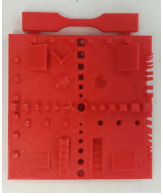In a three-year experiment, the COSMIAC Research Center at the University of New Mexico has been researching and testing electronics that have been embedded into 3D printed systems. With funding of $450,000, the research team completed three goals: to design and print simple prototypes with hybrid materials, embedded chips and wiring; to test the designed circuits using COSMIAC’s in-house testing capabilities; and to publish the results for dissemination.
 The team 3D printed, among other things, a circuit board with embedded electronics and subjected it to several experiments, which you can read about in a paper entitled “Environment Testing 3D Electronics Research Program.” The goal of the project was to 3D print a wide variety of different materials and test them in space conditions to determine changes in mass, along with other factors that would help determine which parts have the most potential to survive flight in the future.
The team 3D printed, among other things, a circuit board with embedded electronics and subjected it to several experiments, which you can read about in a paper entitled “Environment Testing 3D Electronics Research Program.” The goal of the project was to 3D print a wide variety of different materials and test them in space conditions to determine changes in mass, along with other factors that would help determine which parts have the most potential to survive flight in the future.
“An example of this type of experiment could be a soldier’s helmet where the electronics that monitor health and location are embedded into the material from which the helmet is created,” the researchers state. “The designer could reduce or eliminate much of the traditional spider web of wiring. In traditional satellite design, if any of the wires are crimped or broken, the satellite is rendered inoperative. There is no redundancy in flight. A much more reliable solution would be a satellite where all the wiring is embedded into the structural walls where it cannot be accessed or damaged. It should be possible to plug in the modules to an embedded backplane.”
Experiments were developed to measure the 3D printed objects’ electromagnetic properties among other factors. Three different 3D printers were used: a MakerBot, a Stratasys uPrint, and a 3D Systems ProJet 3500 3D printer. To test the various 3D printers’ capabilities, a CubeSat with entirely 3D printed components was produced.
“This process was an excellent opportunity for the students to see how to print a satellite body and then be able to use the components for performing fit checks on the modules and their associated hole and thread spacing,” the researchers continue. “The satellite shown was then used to make measurements for determining how long to make cables for the real satellite.”
Printed circuit boards were 3D printed from 16 different materials and subject to multiple tests. The FDM materials showed a great deal of moisture change where the SLA 3D printed items didn’t, making them more ideal for space applications.
“The team achieved the original objectives as well as going into other areas of investigation that were of interest to the space community as more and more spacecraft activities are looking to use 3D printing for satellite development,” the researchers state. “The outcome is that excellent advances have been made in the areas of 3D printing for space but that the ability to print space qualified and repeatable systems for future nanosatellite applications is still probably a decade in the future.”
In conclusion, the researchers indicate that 3D printing is not quite ready for use in government missions for actual flight. It has great benefit for prototyping, however, and in the future it may play a much larger role in the actual fabrication of spaceflight components.
Discuss this and other 3D printing topics at 3DPrintBoard.com or share your thoughts below.
Subscribe to Our Email Newsletter
Stay up-to-date on all the latest news from the 3D printing industry and receive information and offers from third party vendors.
You May Also Like
Profiling a Construction 3D Printing Pioneer: US Army Corps of Engineers’ Megan Kreiger
The world of construction 3D printing is still so new that the true experts can probably be counted on two hands. Among them is Megan Kreiger, Portfolio Manager of Additive...
US Army Corps of Engineers Taps Lincoln Electric & Eaton for Largest 3D Printed US Civil Works Part
The Soo Locks sit on the US-Canadian border, enabling maritime travel between Lake Superior and Lake Huron, from which ships can reach the rest of the Great Lakes. Crafts carrying...
Construction 3D Printing CEO Reflects on Being Female in Construction
Natalie Wadley, CEO of ChangeMaker3D, could hear the words of her daughter sitting next to her resounding in her head. “Mum, MUM, you’ve won!” Wadley had just won the prestigious...
1Print to Commercialize 3D Printed Coastal Resilience Solutions
1Print, a company that specializes in deploying additive construction (AC) for infrastructure projects, has entered an agreement with the University of Miami (UM) to accelerate commercialization of the SEAHIVE shoreline...































